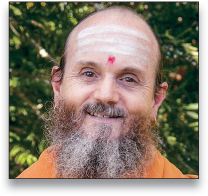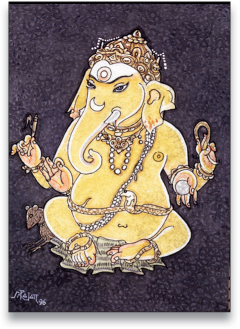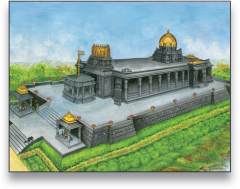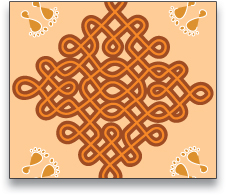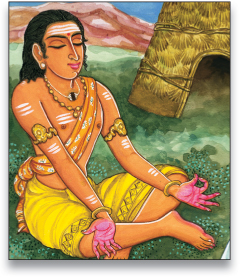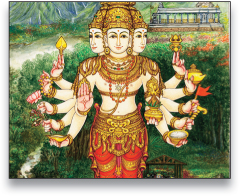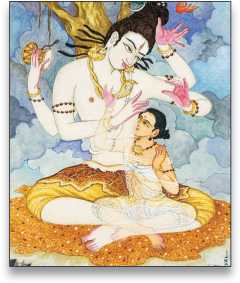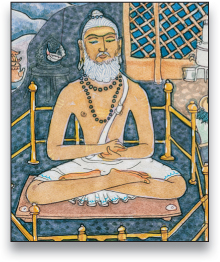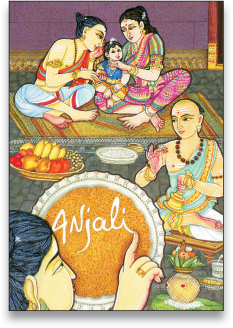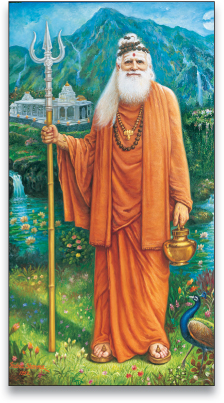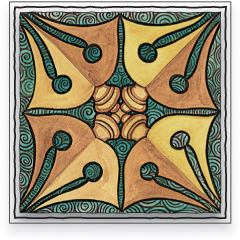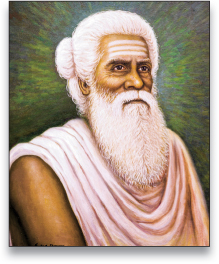Glossary§
affirmation: A positive declaration or assertion that we repeat regularly to impress our mind and thus improve our life in specific ways.§
Agama: A large collection of revealed scriptures written in Sanskrit, describing temple ritual and construction, philosophy and yoga. Saivism, Shaktism and Vaishnavism each have their own Agamas.§
Agamic: Of or pertaining to the Agamas.§
ahimsa: “Noninjury.” Not causing hurt or damage to any living being, or to the environment, by thought, word or deed—even in your dreams.§
Alaveddy: A village in northern Sri Lanka where Satguru Sivaya Subramuniyaswami performed sadhana and established an ashram in the late 1940s.§
anava: Sense of being an individual, separate from God and the world. Anava is part of Lord Siva’s veiling grace.§
anjali mudra: A gesture of respect and greeting in which the two palms are held gently together, slightly cupped, usually in front of the heart.§
Antarloka: “Inner or in-between world,” known in English as the subtle or astral plane. It is the intermediate dimension between the physical and causal worlds, where souls function in their astral bodies between incarnations—being helped to readjust to not having a physical body, and eventually prepared for yet another birth—and during sleep. See subtle plane.§
anugraha: Siva’s revealing grace, which frees the mature soul from anava, karma and maya.§
Appar: “Father.” Tirunavukkarasar, one of the four great Tamil Nalvar saints.§
arati: The waving of a lighted lamp, as done before the Deity at the high point of puja.§
artifact: A special man-made object, such as a statue of a Deity.§
asana: Any of numerous hatha yoga positions, each with specific benefits. These postures balance the energies of mind and body, promoting health and serenity. Asana is the third limb of ashtanga yoga. Gurudeva’s system of twenty-four sequential asanas relieves stress and prepares mind and body for meditation.§
ascetic: One who leads an austere and highly disciplined life, shunning comforts and pleasures, for religious goals.§
ashram: The home of a guru or Hindu monk.§
ashtanga yoga: The eightfold system of yoga described in Patanjali’s Yoga Sutras, comprising yama, niyama, asana, pranayama, pratyahara, dharana, dhyana and samadhi—each stage building on those before.§
astral plane: Second World. See Antarloka.§
Aum: A sacred mantra, or sound, that is present at the beginning of many scriptures and chants. The primal vibration from which all manifestation issues forth.§
Aum Gaṁ Gaṇapataye Namaḥ: “Praise be to Ganapati,” a sacred mantra for Lord Ganesha.§
aura: The luminous, colorful field of subtle energy radiating within and around the human body, extending out from three to seven feet. The colors of the aura change constantly according to the ebb and flow of one’s state of consciousness, thoughts, moods and emotions. Higher, benevolent feelings create bright pastels; base, negative feelings are darker in color. Auras can be seen and “read” by clairvoyants.§
austere: Without comfort or luxuries.§
Auvaiyar: A saint of Tamil Nadu (ca 200 bce), devotee of Lord Ganesha and Karttikeya. She wrote exquisite ethical works, some in aphoristic style and some in four-line verse. Her Tamil primer is studied by schoolchildren to this day.§
Batu Caves: Famous caves on the outskirts of Kuala Lumpur, Malaysia. A Murugan temple is inside the largest cave. Alongside the 272 steps leading up to the cave stands a beautiful 140-foot-tall statue of Lord Murugan.§
Bengaluru: A city formerly known as Bangalore, in the South Indian state of Karnataka.§
bhajana (bhajan): Spiritual song. Individual or group singing of devotional songs, hymns and chants.§
bhakti: Religious devotion.§
bhakti yoga: The practice of devotional disciplines, worship, prayer, chanting and singing with the aim of awakening love in the heart and opening oneself to God’s grace. Bhakti may be directed toward God, Gods or one’s spiritual preceptor.§
Bhogar Rishi: A great Saivite siddha who did intense yoga in a cave at the site of Palani Hills temple in Tamil Nadu, India. He is known for creating the enshrined murti that is worshiped to this day, using nine medicinal substances.§
Bhuloka: The physical world we perceive with our five senses, and in which we function in our physical body. The First World.§
Bhumi Devi: “Earth Goddess.” The name of Earth given in Hindu scripture, so beloved as to be revered as the Divine Mother.§
bindi: (Hindi) A dot worn on the forehead between the eyebrows. It is a sign that one is a Hindu. In Sanskrit it is called bindu, and in Tamil, pottu.§
Bodhinatha Veylanswami, Satguru: The current guru of the Kailasa Parampara, the successor of Satguru Sivaya Subramuniyaswami.§
bond: Restraint, fetter.§
Buddhism: A religion that arose out of Hinduism based on the teachings of Siddhartha Gautama, the Buddha (624–544 bce). Followers seek to overcome greed, hatred and delusion and to attain enlightenment by following the Eightfold Path and realizing the Four Noble Truths. Its primary scripture is the Dhammapada.§
chakras: Great force centers, areas of consciousness, in our inner bodies. The seven principal chakras can be seen psychically as colorful, multi-petaled wheels or lotuses. They are situated along the spinal cord from the base to the cranial chamber. Seven lower chakras, barely visible, exist in the legs and feet. These are seats of instinctive consciousness, the origin of jealousy, hatred, envy, guilt, sorrow, etc. They constitute the lower or hellish world, called Naraka or patala. The highest seven chakras, accessible after Self Realization, exist above the head.§
charya pada: “Stage of [good] conduct.” The first stage of human unfoldment, where one learns to live righteously and serve selflessly, performing karma yoga. Traditional acts of charya include cleaning the temple, lighting lamps and collecting flowers for worship. Worship at this stage is mostly external.§
Chellappaswami: A satguru who lived in Jaffna, Sri Lanka (1840–1915). He was the guru of Satguru Yogaswami, who in turn was guru to Satguru Sivaya Subramuniyaswami.§
Chidambaram: A South Indian city, site of the famous Thillai Nataraja Siva temple (often simply called Chidambaram Temple).§
Christianity: The faith based upon the teachings of Jesus Christ. Its main scripture is the Bible.§
Confucianism: A system of philosophy and ethics founded by Confucius in China around 500 bce.§
consideration: Being thoughtful and sensitive to the feelings and needs of others.§
cosmos: The whole of creation—all three worlds—seen as harmonious and complete.§
creed: An authoritative, clearly expressed declaration of the core beliefs of a religion.§
Dakshinamurti: Siva as the guru seated under a banyan tree, silently teaching four rishis seated before him.§
darshan: Seeing the Divine. Beholding with our inner or outer vision, a temple image, Deity, holy person or place, with the desire to inwardly contact and receive blessings, and to be seen by that Divinity.§
death: Termination of the physical body due to accident, disease or old age. The soul’s detaching itself from that form and continuing on in the subtle body with the same desires, aspirations and activities as when it lived in a physical body.§
Deity: God or a God. Deity also names the murti, or image, through which a Divinity can send blessings, especially during puja.§
denominations: The various groups within a religion which hold varying beliefs.§
deva: “Shining one.” A soul inhabiting the higher astral plane in a subtle, nonphysical body. Deva is also used in scripture to mean “God or Deity.”§
Devaram: The collection of religious songs of Appar, Sundarar and Sambandar, three of the Tamil Nalvar saints.§
Devi: An alternate name for Shakti, the Goddess, used especially in Shaktism.§
Dhammapada: The most important scripture of Buddhism. It is a collection of sayings of the Buddha in verse form.§
dharana: Concentration. Focusing awareness on a single object or area and not letting it wander. The sixth stage of ashtanga yoga.§
dharma: “Righteousness.” From dhri, “to sustain; carry, hold.” The inherent order of the universe. Divine law as it applies to all things and all beings. The term has many meanings, including: law of being, religion, duty, virtue and truth.§
dhyana: True meditation, a quiet, alert, powerful state in which knowledge comes from within; the seventh limb of ashtanga yoga. It is the result of prolonged concentration.§
dualism: The philosophical concept that there are two eternally separate principles, entities or truths. It is often contrasted to monism.§
essence of the soul: The two aspects of the soul that are identical with Siva: pure consciousness and absolute reality. They are eternal and perfect; whereas our soul’s third aspect, the soul body, is immature and not yet identical with the Primal Soul.§
evolution: Gradual development, usually over long periods of time.§
fast: Not taking any or some kinds of food or drink for a certain period of time.§
festival: Special day (or days) of religious celebration and worship, usually annual.§
Ganapati: “Leader of the ganas.” One of Lord Ganesha’s many names; synonymous with Ganesha.§
Ganas: a kind of deva who help God Siva.§
Ganesha: a Mahadeva, the beloved elephant-faced Deity honored by Hindus of every sect. He is the Lord of Obstacles (Vighneshvara), revered for His great wisdom and invoked first before any undertaking, for He knows all intricacies of each soul’s karma and the perfect path of dharma that makes action successful. He sits on the muladhara chakra and is easy of access.§
Ganesha Chaturthi: The birthday celebration of Lord Ganesha, a ten-day festival in August-September. On the last day, Ganesha Visarjana, we release Ganesha to His Third-World home by immersing His murti in water to dissolve.§
God: Lord Siva, the Supreme Being, creator of the universe and everyone and everything in it. The word God can also refer to great beings like Lord Ganesha or Lord Murugan who serve Lord Siva and were created by Him. See Gods.§
Goddess: Female representation or manifestation of Divinity; Shakti or Devi. God as female. In truth, God is neither male nor female.§
Gods: Extremely advanced beings, such as Lord Ganesha or Lord Murugan, created by Lord Siva to perform grand cosmic functions, such as aiding souls in our evolution.§
Gorakshanatha: A great Saivite guru who lived in North India and Nepal around 950 ce. He was a siddha yoga master of the Adinatha lineage and the foremost guru of Siddha Siddhanta.§
grace: A gift from God given out of His love. More broadly, Siva’s grace is twofold. Concealing grace, tirodhana shakti, binds the soul with the three bonds of anava, karma and maya. This purposeful limiting of consciousness enables the soul to grow and mature through experience of the world. Revealing grace, anugraha shakti, is God Siva’s power of illumination, through which the matured soul is freed from those bonds and ultimately attains liberation, moksha.§
guardian devas: Inner-world helpers assigned to an individual at birth, or at their formal entrance into Hinduism. Each family has numerous guardian devas who assist the family, bless the home and keep the spiritual vibration strong. Every religion has its own guardian devas.§
guru: A title for a teacher or guide in any subject, such as music, dance or sculpture, but especially religion. For clarity, the term is often preceded by a qualifying prefix: a kulaguru is a family teacher, a vinaguru is a vina teacher and a satguru is a spiritual preceptor.§
guru lineage: A line of gurus. Each passes the spiritual power to the next through initiation.§
guru puja: Worship of the guru by bathing his feet and presenting offerings.§
Guru Purnima: A festival day to honor one’s guru. It takes place every year during the full moon in July.§
Gurudeva: An affectionate, respectful term used by devotees for their guru. Used in this book, it refers to Satguru Sivaya Subramuniyaswami.§
Hari-Hara: A Deity image (murti) whose right half is Siva and left half is Vishnu, showing that these two most popular traditional forms of the Divine are actually one being, not two. Hari is a name for Vishnu, and Hara is a name for Siva.§
hatha yoga: A system of physical positions (asanas) and associated mental exercises. The third limb of ashtanga yoga, it quiets the mind and body in preparation for meditation. Hatha yoga is sometimes presented from a solely physical and health standpoint. See asana.§
Himalayas: “Abode of snow.” The highest mountain ranges in the world. They run 2,400 km between India and China from Kashmir to Assam.§
Hindu: A follower of the Hindu religion, distinguished by a Hindu name. As an adjective: pertaining to the Hindu faith.§
Hinduism: India’s indigenous religious and cultural system, followed today by nearly one billion adherents, mostly in India, but with large populations in many other countries. Also called Sanatana Dharma, “eternal religion,” and Vaidika Dharma, “religion of the Vedas.” Hinduism is the world’s most ancient religion and encompasses a broad spectrum of philosophies ranging from pluralistic theism to absolute monism. It is a family of myriad faiths with four primary denominations: Saivism, Vaishnavism, Shaktism and Smartism.§
holy ash: see vibhuti.§
homa: A sacred Vedic fire ceremony, an ancient way of worshiping God and Gods.§
instinctive nature: The urges that come from the physical body and the lower mind, such as self-preservation, procreation, hunger, thirst, greed, hatred, anger, fear, lust and jealousy.§
intellectual nature: The mental aspect of humans: the power to think, discriminate, analyze, reason and make plans.§
Iraivan Temple: A Chola-style Siva temple on Kauai island in the state of Hawaii, USA. It is the only temple in the West built entirely of hand-carved granite stone. Located in the heart of a traditional Hindu monastery complex reminiscent of ancient mathas and aadheenams of India, Iraivan is a pilgrimage destination, a place of sadhana and spiritual rejuvenation.§
Islam: The religion founded by Prophet Mohammed in Arabia about 625 ce. Its principal scripture is the Koran.§
Jaffna: The main city of northern Sri Lanka and the name of the penninsula where it is located.§
Jainism: An ancient non-Vedic religion of India that emphasizes ahimsa. Mahavira was a great Jain teacher who lived around 500 bce.§
japa: Repetition of a mantra, or sacred sound, with concentration. Japa is done silently or aloud, often keeping count on a strand of beads. This practice is called japa yoga or mantra yoga.§
jayanti: “Birthday,” such as guru jayanti, the birthday of one’s guru.§
jnana pada: “Stage of wisdom.” The fourth stage of human evolution, the outcome of perfecting the stages of charya, kriya and yoga.§
Judaism: The religion of the Jewish people. The Torah is their principal scripture. Judaism began about 3,700 years ago in the Near East, chiefly Canaan (now Israel) and Egypt.§
jyoti: Light, radiance, brightness. The inner light seen within the mind in meditation is a form of Siva consciousness.§
jyotisha: Hindu astrology. The knowledge and practice of analyzing events and circumstances, delineating character and determining auspicious moments, according to the positions and movements of heavenly bodies.§
Kadaitswami: The guru of Chellappaswami, 1820-1875. He came from Bengaluru, India, to Jaffna, Sri Lanka, to teach Saivism.§
Kailasa Parampara: The spiritual lineage of Satguru Bodhinatha Veylanswami, his Gurudeva and all the preceptors that preceded them. Part of the Nandinatha Sampradaya.§
kalas: Arts and skills of cultured living, such as singing, dancing and garland making. There are 64 cultural arts, or kalas, in Hindu tradition§
Karaikkal Ammaiyar: A Saivite saint who lived in the 5th century ce. She was a great mystic poet and yogini who composed important hymns, which are part of Tirumurai.§
karma: 1) Any act or deed; 2) the principle of cause and effect; 3) a consequence or fruit of action, which sooner or later returns upon the doer. Selfish, hateful acts will bring suffering. Benevolent actions will bring loving reactions. Karma is a neutral law of the inner cosmos, much as gravity is an impersonal law of the outer cosmos.§
karma yoga: Selfless service as a means of spiritual unfoldment. Karma yoga, seva, is an important part of the charya pada.§
Karttikeya: One of Lord Murugan’s many names, meaning “child of the Pleiades” constellation.§
Kashi: Alternate name for Varanasi. See Varanasi.§
Kashi Vishwanath: A famous Siva temple in Varanasi, India.§
Kauai’s Hindu Monastery: Kauai Aadheenam, the monastery/temple complex established in Hawaii, USA, by Satguru Sivaya Subramuniyaswami.§
kavadi: A decorated yoke/arch placed across one’s shoulders and used to carry two milk pots to the temple during Muruga festivals.§
Kerala: A state on India’s southwestern coast.§
kolam: A traditional Hindu decoration drawn on the ground or floor during festivals or weddings, and daily at one’s doorway. Kolams are made using plain or colored rice powder, pulse grains or flower petals. They are only intended to last a few days. Designs may be simple or elaborate.§
kriya pada: “Religious action or worship stage.” The second stage of human unfoldment, of bhakti yoga, cultivating devotion through performing puja and regular daily sadhana. A central practice of the kriya pada is performing daily puja.§
Kumbha Mela: A Hindu gathering held periodically at four sacred cities in rotation over a 12-year period: Prayag (Allahabad), Nasik, Haridwar and Ujjain. The exact dates are set by astrological calculations and are not evenly spaced over the 12 years. Attendance at Prayag numbers up to 120 million people over the course of the festival and 30 million on a single day, making it the largest assembly of humans on Earth for any one event.§
Kumbhalavalai Temple: A powerful Ganesha temple in Alaveddy, Sri Lanka.§
kumkum: A red powder applied to the forehead. (Kumkum is the Hindi form; kunkumam is Tamil, and kunkuma is Sanskrit.)§
kundalini: “She who is coiled; serpent power.” The cosmic energy in every individual which, at first, lies coiled like a serpent at the base of the spine and eventually, through the practice of yoga, rises and stimulates each successive chakra.§
kundalini yoga: “Uniting the serpent power.” Advanced meditative practices and sadhana techniques, a part of raja yoga, performed to arouse the kundalini power and guide it up the spine into the crown chakra, sahasrara. In its highest form, this yoga is the natural result of sadhanas and tapas well performed, rather than a distinct system of striving and teaching.§
liberation: Release from the round of births and deaths. See moksha.§
Lingam: Same as Sivalinga. See Sivalinga.§
macrocosm: The manifest physical universe. See also microcosm.§
Madurai: A city in Tamil Nadu, South India. The great Meenakshi-Sundareshvara Temple is there.§
Mahadeva: “Great shining one; God.” A worshipful term used to refer to God Siva, and to highly evolved beings, such as Lord Ganesha and Lord Murugan, created by Lord Siva to perform grand cosmic functions, such as aiding souls in our evolution.§
Mahakaleshwar: A ancient and famous Siva temple in Ujjain, Madhya Pradesh, India.§
maharishi: “Great seer.” Title for a great saint.§
Mahasivaratri: The biggest Siva festival of the year. It is celebrated on the night before the new moon in February-March. Fasting and an all-night vigil are observed as well as other disciplines: chanting, praying, meditating and worshiping Siva as the Source and Self of all that exists.§
malas: “Impurities.” An important term in Saivism referring to the three bonds (pasha), anava, karma, and maya, which limit the soul, preventing it from knowing its true, divine nature. Mālā (long a’s) names a looped strand of beads for holy recitation, japa, usually made of rudraksha, tulasi, sandalwood or crystal. Also, a flower garland.§
manifest energy: God’s energy, Shakti, which you can see and feel.§
Manikkavasagar: A Tamil saint who contributed to the medieval Saivite renaissance (ca 850). He gave up his position as prime minister to follow a renunciate life. His poetic Tiruvasagam, “Holy Utterances,” a major Saiva Siddhanta scripture, is a jewel of Tamil literature. There he express his aspirations, trials and yogic realizations. His Tiruvasagam and Tirukovaiyar are part of the eighth Tirumurai.§
mantra: A sacred Sanskrit word, phrase or sentence from scripture, chanted during puja, as japa, or as a blessing before meals, at gatherings, etc.§
mantra yoga: The practice of japa, chanting mantras to aid in spiritual unfoldment. See japa.§
Matsyendranatha: A great Natha guru who lived in the 9th century ce. A patron saint of Nepal.§
maya: The substance emanated from Siva through which the world of form is manifested. Hence all creation is also termed maya. It is the cosmic creative force, the principle of manifestation, ever in the process of creation, preservation and dissolution. Maya is a key concept in Hinduism, often differently translated as “illusion.”§
meditation: Sitting quietly, controlling the breath, stilling the thought waves and going within ourself. Through meditation we can unfold new knowledge and study awareness.§
Meykandar: A 13th-century Tamil pluralistic Saiva Siddhanta theologian, founder of the Meykandar Sampradaya.§
microcosm: “Little world” or miniature universe.” The inner world, from which the macrocosm issues forth. See also macrocosm.§
moksha: “Liberation.” The soul’s release from the cycle of births and deaths. This occurs after all dharma has been fulfilled, all karma resolved and God Realization attained. The soul then continues to evolve in the inner worlds.§
monastery: A home or ashram for monks, usually under the guidance of a satguru.§
monastic: A monk or nun. An unmarried man or woman who lives an austere religious life.§
monism: The doctrine that there is only one ultimate substance or principle; the perspective that reality is a unified whole.§
monistic theism: Monism is the doctrine that reality is a one whole or existence without independent parts. Theism is the belief that God exists as a real, conscious, personal Supreme Being. Monistic theism (also called panentheism) embraces both monism and theism. The Sanskrit equivalent of monistic theism is advaita Ishvaravada.§
Mount Kailas: A Himalayan mountain sacred to Lord Siva.§
mudras: Esoteric gestures used in puja, dance and yoga to express specific energies or powers or to communicate meaning.§
muladhara chakra: The chakra of memory, at the base of the spine. Seat of Lord Ganesha and beginning of the spiritual path.§
Mumbai: A major city in India’s Maharashtra state, formerly known as Bombay.§
murti: An image or icon of God or a God that is the focus of worship rites, called puja. Murtis are made of stone or metal and sometimes wood.§
Murugan: The second son of Lord Siva, brother of Lord Ganesha. A Mahadeva worshiped in all parts of India and throughout the world. This God of yoga and spiritual striving holds the holy vel of jnana shakti, which is His power to vanquish darkness or ignorance.§
Mushika: Ganesha’s mount, the mouse, symbolizing abundance, carrying Ganesha’s grace everywhere.§
mystic: One who pursues spiritual disciplines aimed at union or communion with Ultimate Reality, God, through deep meditation or trance-like contemplation.§
mysticism: Spirituality. The pursuit of personal spiritual or religious experience.§
nada: Sound. Metaphysically, the subtle, mystic sounds of the Eternal. One form of nada is the high “eee” sound inwardly heard by meditators.§
Nalvar: “The four.” The four most highly revered Tamil Saiva saints: Appar, Sundarar, Sambandar and Manikkavasagar.§
Namaḥ Śivāya: “Praise to Siva.” The foremost mantra for Saivites, known as the Panchakshara or “five syllables.” Na is the Lord’s veiling grace; Ma is the world; Śi is Siva; Vā is His revealing grace; Ya is the soul.§
namaskar (or namaskaram): “Reverent salutations.” Virtually equivalent to namaste. The most common verbal greeting used among Hindus. As the word is pronounced, the palms are often held together in anjali mudra before the heart or raised to the level of the forehead with the head slightly bowed. It is a devotional gesture made equally before a temple Deity, holy person, friend or momentary acquaintance.§
namaste: “Respectful greetings to you.” A traditional verbal greeting. Hands are in anjali mudra.§
Nandinatha: The first known guru of the Nandinatha Sampradaya, and of the Kailasa Parampara. He lived around 250 bce.§
nonviolence: Ahimsa in Sanskrit. To avoid causing harm or pain to others, physically, mentally or emotionally.§
Nataraja: God Siva as Cosmic Dancer. This is Siva’s intricate state of Being in Manifestation. The dance of Siva is the dance of the entire cosmos, the rhythmic movements in all. All that is, whether sentient or insentient, pulsates in His body. Dance and dancer are one; not an atom moves on any plane of existence but by His Will. Thus, this elegant symbol embodies the underlying unity of all.§
Natha Sampradaya: The oldest Saivite stream of teaching. The Nandinatha Sampradaya is one of its branches.§
niyama: The observances by which we cultivate our spiritual nature. Niyama is the second limb of ashtanga yoga.§
Odissi: A form of Indian dance from Orissa state, India.§
padas: The four progressive, cumulative stages of each soul’s maturation: charya, kriya, yoga and jnana.§
Palani Hills: The site of a large and famous Murugan temple in Tamil Nadu, South India.§
Panchabrahma: The form of Siva with five faces, representing His five powers.§
Panchakshara: “Five-lettered chant.” Namaḥ Śivāya, Saivism’s foremost sacred mantra.§
pancha nitya karmas: Five essential Hindu practices: 1) worship (upasana); 2) holy days (utsava); 3) pilgrimage (tirthayatra); 4) virtuous living (dharma); and 5) rites of passage (samskaras).§
Parameshvara: The Primal Soul, Supreme Mahadeva, Siva-Shakti. God’s personal perfection, who acts, wills, blesses, gives darshan, guides, creates, preserves, reabsorbs, obscures and enlightens.§
parampara: A lineage (of gurus). The spiritual power is passed from one to the next by initiation.§
Parashakti: “Supreme power; primal energy.” God Siva’s impersonal, all-pervasive Pure Consciousness, the Primal Substance of all that exists. It is also called Satchidananda.§
Parasiva: The Self God. Siva’s first perfection, Absolute Reality, transcending time, form and space.§
pasha: All of existence, manifest and unmanifest. The soul’s threefold bondage of anava, karma and maya. That which binds or limits the soul.§
pashu: In Hindu philosophy, pashu refers to the soul. It can also refer to all creatures including man. The literal meaning is “cattle.”§
Pashupatinath: The foremost temple of Nepal, dedicated to Lord Siva, “Lord of souls.”§
Pati, pashu, pasha: God, soul, world—the three primary elements of philosophy. Literally: “master, cow and tether.”§
penance: Actions done to atone for misdeeds.§
perfections (three): Qualities, dimensions or aspects that are perfect. A term used to describe God Siva’s three flawless aspects. Perfection one: Siva is the Absolute Reality (Parasiva) that transcends all but is the foundation of everything. Perfection two: Siva is immanent, pervading all existence as the Pure Consciousnesss (Parashakti) within all. Perfection three: Siva exists in personal form as Primal Soul (Parameshvara), creator of all.§
pottu: In Tamil, the small dot (also called bindi or bindu) worn on the forehead, which identifies one as a Hindu. It is usually made of kumkum (red powder) or sandalwood paste. Widows and unmarried girls traditionally wear a black pottu.§
prana: Vital energy. Usually prana refers to the life principle, such as in the human body, but sometimes denotes energy, power or the animating force of the cosmos.§
pranayama: The practice of controlling prana (subtle energy) through breathing techniques. Pranayama quiets the mind and balances the masculine and feminine (pingala and ida) energies. This is the fourth limb of ashtanga yoga.§
prasadam (or prasada): A gift of food offered to God, Gods or guru, or a portion of offerings that is shared with devotees.§
pratyahara: Withdrawal of awareness from externalities—first from the physical senses, then from emotion and intellect. The fifth limb of ashtanga yoga.§
Primal Soul: The uncreated, original, perfect soul, Parameshvara. God in His personal aspect as Lord and Creator, who emanates from Himself all of creation—the inner and outer universes and all individual souls. The essence of each soul is the same as His: Satchidananda and Parasiva.§
puja: A Hindu form of worship, a ritual ceremony that includes offerings of incense, water, food and flowers, presentation of lighted lamps, chanting of Sanskrit verses and, usually, the ringing of bells—all of which help to establish communion with the God being worshiped.§
raja yoga: The classical yoga system of eight progressive stages to Illumination as described in various yoga Upanishads, the Tirumantiram and, most notably, the Yoga Sutras of Patanjali, who called it ashtanga (eightfold) yoga.§
Rameshwaram: A town at the southern tip of India, site of the large, ancient Ramanathaswamy Siva Temple founded by Lord Rama.§
reincarnation: “Reentering the flesh.” The process in which a soul is reborn on Earth to continue its evolution. It is a repetitive cycle, known as punarjanma in Sanskrit, which originates in the subtle plane. See Antarloka.§
rishi: “Seer.” A term for an enlightened being, emphasizing psychic perception and visionary wisdom.§
Rishi from the Himalayas: The first recently known siddha of the Kailasa Parampara; guru of Kadaitswami.§
rudraksha: A reddish seed sacred to Lord Siva, worn by devotees and strung on malas for japa.§
sadhana: Religious and spiritual disciplines, such as puja, yoga, meditation, japa, fasting and austerity.§
sadhana marga: The path of intense effort, spiritual discipline and consistent inner transformation, as opposed to theoretical and intellectual learning.§
sadhu: A holy man dedicated to the search for God. Feminine: sadhvi.§
Saiva: Same as Saivite. See Saivite.§
Saiva Agamas: Revealed scriptures specific to Saivism, supplementing the Vedas. Strongly theistic, they identify Siva as the Supreme Lord, immanent and transcendent. There are 28 Saiva Siddhanta Agamas and 64 Kashmir Saiva Agamas.§
Saiva Siddhanta: “Final conclusions of Saivism.” Theology based on the 28 Saiva Siddhanta Agamas. For Saiva Siddhantins, Siva is the totality of all, understood in three perfections: Parameshvara (the Personal Creator Lord), Parashakti (the substratum of all form) and Parasiva (Absolute Reality, which transcends all). Souls and world are identical in essence with Siva, yet also differ in that they are evolving. The first known guru of the Shuddha (“pure”) Saiva Siddhanta tradition was Maharishi Nandinatha of Kashmir (ca bce 250). A pluralistic stream of Saiva Siddhanta arose in the middle ages from the teachings of Aghorasiva and Meykandar.§
Saivam: The Tamil word for Saivism. It also means vegetarian.§
Saivism: The religion of those who worship Lord Siva as the Supreme God. The oldest of Hinduism’s four major denominations.§
Saivite: Of or relating to Saivism or its adherents, who number about 400 million in the world today. Same as Saiva.§
samadhi: The goal of yoga, a state in which the meditator and the object of meditation are one. Savikalpa samadhi is oneness with the essence of an object, or with Pure Consciousness. Nirvikalpa samadhi, Self Realization, transcends all consciousness.§
Sambandar: A child saint who lived in the 7th century and composed many devotional songs, Devaram, in praise of Siva. He is honored as one of the four Tamil Nalvar saints.§
samhara: God Siva’s cosmic power of destruction or dissolution.§
samsara: The repetitive cycle of birth, death and rebirth. More broadly, samsara refers to the phenomenal world, transmigratory existence, the realm of impermanence and change.§
samskara: Rites of passage marking a significant transition in life, such as name-giving, first feeding, ear-piercing, beginning of study, coming of age, marriage and funeral rites. Also refers to any deep impression made on the subconscious mind.§
sangam: Coming together in a group, especially for religious purposes. Fellowship; religious gathering.§
San Marga: “True path.” The straight, spiritual path leading to the ultimate goal, Self Realization, not detouring into psychic exploration or the development of siddhis.§
Sanatana Dharma: “Eternal religion” or “everlasting path.” A traditional designation for the Hindu religion.§
sannyasin: A Hindu monk, unmarried and celibate; a swami. One who has renounced family, possessions and career to follow a religious life, fully devoted to God, without any distractions. One becomes a sannyasin by being initiated (given sannyas diksha) by another sannyasin, ideally a satguru. Feminine: sannyasini.§
Sanskrit: The ancient language of India in which thousands of texts are written, including the shruti, revealed Hindu scriptures (Vedas and Agamas).§
santosha: Contentment. Being happy and satisfied with what one has.§
Saravanabhava: A mantra invoking Lord Karttikeya (Murugan), the great guardian of the spiritual quest. It describes the mind as a peaceful, undisturbed lake.§
Satan: The devil; evil personified—a being propounded by Christianity and other Semitic faiths, believed to oppose God’s will and tempt souls into wickedness. In Hinduism, all is seen as the manifestation of God. Our ignorance, fears and desires can lead to wicked actions, but there is no Satan.§
satguru: A great religious teacher who is close to God and guides others on the right path.§
satsanga: A holy gathering. Association of a group of devotees for non-temple worship and religious study.§
sect: A denomination or other group within a religion. This term is often used in a derogatory sense.§
sectarian: Having to do with a religious sect or denomination.§
Self Realization: Direct knowing of the Self God, Parasiva, by transcending consciousness itself. It is the culmination of yoga—attained only by a rare few in any lifetime, but eventually by all souls.§
seva: Service, karma yoga, doing useful work for others without thought of reward.§
Shaktas: Those who follow Shaktism, one of the four major denominations of Hinduism.§
Shakti: “Power, energy.” The active power or energy of Siva, worshiped as the Supreme Being, the Goddess, by followers of Shaktism. In Saivism, this power is regarded as an aspect of Siva, who encompasses all, including male and female.§
Shaktism: The religion of those who worship the Supreme as the Divine Mother. One of the four major Hindu denominations.§
Shanmukhanatha: “Lord with six faces.” One of Lord Murugan’s many names.§
shanti: Inner peace, tranquility, bliss.§
shastras: Authoritative religious or philosophical writings. The term means “text” or “teaching.”§
Shri Rudram: “(Hymn) to the wielder of awesome powers.” Preeminent Vedic hymn to Lord Siva as the God of dissolution, located in the middle of the first three Vedas. It is chanted often in Siva temples throughout the world. It is within this long prayer that the mantra Namaḥ Śivāya first appears.§
shrishti: One of God Siva’s five powers, that of creation or emanation.§
shruti: That which is “heard” (by great sages). Shruti refers to Hinduism’s revealed scriptures, the Vedas and Agamas.§
Shuddha (pure) Saiva Siddhanta: The oldest school of Saiva Siddhanta, the monistic theism of Maharishi Nandinatha. Besides the Vedas and Saiva Siddhanta Agamas, its scriptures include the Tirumantiram, Tirumurai and Tirukural.§
siddha: an accomplished yogi; one who has attained great spiritual attainment or powers.§
Sikhism: The religion founded by Guru Nanak about 500 years ago. A reformist faith, Sikhism rejects murti worship and the caste system. Its holy book is the Adi Granth, and its main center is the Golden Temple of Amritsar. The word for a follower of this faith is Sikh, which means “disciple” in Punjabi.§
sin: Intentional transgression of dharma, divine law. Sin reaps painful karma, causing the soul to learn and evolve. We eventually rise above all misbehavior as we unfold our innate Godliness.§
Siva: The “auspicious,” “gracious,” or “kindly one.” The Supreme Being as worshiped in the Saivite religion. God Siva is All and in all, simultaneously the creator and the creation, both immanent and transcendent. He is a one Being, perhaps best understood in three perfections: Parameshvara (Primal Soul), Parashakti (Pure Consciousness) and Parasiva (Absolute Reality). See perfections.§
Sivachaitanya Panchatantra: Concentrating on five successive forms of Siva consciousness, one after the other: vital breath, all-pervasive energy, sacred form, inner light and sacred sound.§
Sivalinga: “Mark, or sign, of Siva.” Found in nearly all Siva temples, this icon, usually an oval-shaped stone set in a circular base, is the most ancient symbol of Siva, especially of Parasiva, the Ultimate Reality beyond all forms and qualities. Syonymous with Lingam.§
Sivaloka: The third world, realm of Siva, the Gods and highly evolved souls. The Sivaloka is the highest, or most refined, part of the heavenly worlds.§
Smarta: A follower of Smartism, one of the four major Hindu denominations.§
Smartism: One of the four major denominations of Hinduism. Its name derives from its basis on the secondary scriptures (smṛiti), especially the Ramayana, the Mahabharata (which includes the Bhagavad Gita), Puranas and Dharma Shastras. Smartism is an ancient Vedic brahminical tradition (ca 700 bce). From the 9th century onward it was guided and deeply influenced by the Advaita Vedanta teachings of the famous Adi Shankara. Smartas worship all the Gods as representations of the Supreme Being and discourage sectarianism. For spiritual authority, Smartas look to the regional monasteries established across India by Shankara. These are the headquarters of ten orders of renunciate monks.§
smriti: That which is “remembered;” the tradition. Hinduism’s nonrevealed, secondary but deeply revered scriptures, derived from human insight and experience. Smriti texts speak of secular matters as well as spiritual lore. 1) The term refers to certain collections of ancient Sanskritic texts, such as the Vedangas, Upavedas, Itihasas and Puranas, etc. 2) In a general sense, smriti may refer to any text other than shruti (revealed scripture) that is revered as scripture within a particular sect or lineage. The selection of smriti varies widely from one sect and lineage to another.§
soul: The real being of humans, as distinguished from body, mind and emotions. The soul—known as atman or purusha in Sanskrit—has two aspects: the form or body of the soul, which matures over many lifetimes into perfect identity with Parameshvara, and the essence of the soul, which is already perfect as Parashakti and Parasiva.§
Sri Lanka: Island nation off the southern tip of India. It was formerly called Ceylon. Several million Tamil Saivites live here, mostly in the east and north.§
sthiti: “Preservation.” One of the five powers of God Siva.§
sublime: Excellent, grand. Inspiring awe or reverence.§
Subrahmanya: One of Lord Murugan’s many names. It means “very pious; dear to holy men.”§
Subramuniyaswami, Satguru Sivaya: Satguru (1927–2001) of the Kailasa lineage within the Nandinatha Sampradaya. He was initiated by Yogaswami in 1949 with a powerful slap on the back. His successor is Satguru Bodhinatha Veylanswami. This book embodies his teachings, as drawn from his Master Course Trilogy.§
subtle body: The astral body. The nonphysical, astral body or vehicle in which the soul encases itself to function in the Antarloka, or subtle world.§
subtle plane: The Antarloka or Second World, also called the astral plane. The intermediate dimension between the physical and causal worlds, where souls in their astral bodies sojourn between incarnations and when they sleep. It comprises several levels, from the Devaloka (realm of the devas) to the Narakaloka (realm of asuras, demonic beings). Between incarnations we live fully in the realm of the subtle world that corresponds to our consciousness. See Antarloka.§
Sundaranatha: The original name of Rishi Tirumular, author of Tirumantiram.§
Sundarar: One of the four great Tamil Nalvar saints. He lived around 800 ce.§
superconscious mind: The mind of light, the all-knowing intelligence of the soul. The highest or most refined form of consciousness.§
swami: A renunciate Hindu monk. See sannyasin.§
Tamil: The ancient Dravidian language of the Tamils, spoken by an ethic group of 60 million people.§
Tamil Nadu: A state in South India.§
tandava: “Exuberant dance.” Any vigorous dance sequence performed by male dancers. The prototype is God Siva’s dance of bliss, ananda tandava.§
tapas: Severe austerity, penance, sacrifice performed for purification. The word tapas means “warmth, heat.”§
temple: The English term most commonly used for a building devoted to Hindu worship. The physical-plane home of God. It may be referred to by the Sanskrit terms mandira (Hindi: mandir), devalaya, Sivalaya (a Siva temple), as well as by vernacular terms such as koyil (Tamil).§
ten-minute spiritual workout: A quick daily regimen designed by Satguru Bodhinatha to maintain key spiritual disciplines at extremely busy times in life, such as the student years. The spiritual workout has four parts: worship, introspection, affirmation and study.§
theism: The doctrine that God exists as a real, conscious, personal Supreme Being, creator and ruler of the universe. Theism, in its various expressions, may include belief in the Gods.§
three worlds: The three dimensions of existence: 1) Bhuloka: “Earth world,” the physical plane. 2) Antarloka: “Inner or in-between world,” the subtle or astral plane. 3) Sivaloka: “World of Siva” and of the Gods and other highly evolved souls, the causal plane.§
tilaka: Distinctive marks worn by Hindus on the forehead, made with clay, ashes or sandalwood paste as an indication of specific religious affiliation. The Saivite tilaka, called tripundra, is three horizontal strips of holy ash with a dot at the third eye, below the middle of the forehead.§
tirodhana: “Concealment.” Tirodhana shakti is the particular energy of Siva that binds the three bonds of anava, karma, maya to the soul. This purposeful limiting of consciousness enables the soul to grow and mature through experience of the world.§
tirthayatra: Pilgrimage—one of Hinduism’s five sacred duties (pancha nitya karmas). Preceded by fasting and celibacy, this is a time of austerity, purification and focus on spiritual matters.§
Tirukovaiyar: A collection of 400 devotional songs by Saint Manikkavasagar. This work and the Tiruvasagam by the same author make up the eighth Tirumurai. These profound hymns embody the author’s boundless love for Siva, his visionary experiences and urgent quest for truth.§
Tirukural: A masterpiece on ethics written in Tamil by Saint Tiruvalluvar around 200 bce. Using a super-compact verse form of 14 syllables, the poet presents 133 subjects of ten verses each on God, conduct, relationships, human strengths and foibles, statecraft and more. One of the world’s earliest ethical texts, the Tirukural could well be considered a bible on virtue for the human race. In fact, it is sworn on in South Indian courts of law.§
Tirumantiram: “Holy incantation.” The Nandinatha Sampradaya’s oldest Tamil scripture, written around 200bce by Rishi Tirumular. One of the Tirumurai texts, it is a vast storehouse of esoteric knowledge, including the fundamental doctrines of the 28 Saiva Siddhanta Agamas. Tirumantiram is prized for expressing a unified understanding of Siddhanta and Vedanta.§
Tirumular: One of the first gurus of the Nandinatha Sampradaya; a disciple of Nandinatha. He lived around 200 bce and wrote the Tirumantiram.§
Tirumurai: A 12-book collection of thousands of hymns and writings in praise of Siva, written from the 6th to 11th centuries by numerous South Indian Tamil Saivite saints. It is the most important body of Saiva Siddhanta scripture in Tamil. Books 1-3 are the hymns of Sambandar (ca 600). Books 4-6 are the hymns of Appar, a contemporary of Sambandar. Book 7 contains the hymns of Sundaramurti (ca 800). These first seven books are known as Devarams. Book 8 consists of Saint Manikkavasagar’s (9th century) Tiruvasagam and Tirukovaiyar. Book 9 is the Tiruvisaippa and Tiruppallandu, the works of nine saints. Book 10 is the Tirumantiram of Saint Tirumular (ca 200 bce). Book 11 contains the hymns of ten saints, including Nakkirar and Nambiyandar Nambi, the compiler. Book 12 is the Periyapuranam by Saint Sekkilar (11th century), narrating the life of the 63 Saiva Nayanars.§
Tirunavukkarasar: One of the four great Tamil Nalvar saints, often known as Appar, meaning “father.”§
Tiruvalluvar: The South Indian weaver saint (ca 200 bce) who wrote the Tirukural.§
Tiruvasagam: The lyrical Tamil scripture by Saint Manikkavasagar (ca 850). Considered one of the most profound and beautiful devotional works in the Tamil language, consisting of 658 hymns, it discusses every phase of the spiritual path, from doubt and anguish to perfect faith in God Siva, from earthly experience to the guru-disciple relationship and freedom from rebirth. The work is partly autobiographical, describing how Manikkavasagar, the prime minister to the Pandyan king, renounced the world after experiencing a vision of Siva seated beneath a tree.§
tiruvasi: The ring of flames around the Siva Nataraja murti, symbolizing universal consciousness.§
tolerance: A willingness to accept that others’ beliefs and practices differ from one’s own.§
tripundra: The forehead mark of a Saivite: three horizontal lines of vibhuti (holy ash), representing the burning away of the three bonds (anava, karma and maya). Often with a dot (bindi or pottu) at the third eye. Women usually use less vibhuti. Holy ash is a reminder of the temporary nature of the physical body and the urgency to strive for spiritual attainment and closeness to God.§
Trishula: “Trident.” The three-pronged spear held by Lord Siva, depicting God’s three fundamental powers: ichcha (desire, will, love), kriya (action) and jnana (wisdom).§
Ujjain: A large city in Madhya Pradesh, India. Site of the ancient Mahakaleshwar Siva temple. A traditional holy place of Saivism.§
unremitting: Continuous, never letting up.§
Upanishads: The fourth and final portion of the Vedas, expounding the philosophical meaning of the Vedic hymns, the nature of God, soul and world and the doctrines of reincarnation, karma and liberation. The Upanishads are a collection of profound texts which are the source of Vedanta and have dominated Indian thought for thousands of years. Ten to 16 Upanishads are classified as major or principal.§
upasana: “Sitting near.” Worship or contemplation of God, to be performed daily without fail. This is the core of religious life, the soul’s natural outpouring of love for God and the Gods. One of Hinduism’s five sacred duties (pancha nitya karmas).§
utsava: “Festival.” Religious festival or holy day. Also, the discipline of observing holy days, including home and temple festivals, each year. Utsava is one of Hinduism’s five sacred duties (pancha nitya karmas).§
vahana: “Vehicle.” Each Hindu Deity is associated with a particular animal which He/She uses as a vehicle, symbolizing the Deity’s nature or function. Siva’s bull, Nandi, symbolizes strength and potency; Karttikeya’s peacock, Mayil, beauty and regality, Ganesha’s mouse, Mushika, prosperity and the ability to go anywhere.§
Vaishnavism: The religion of those who hold Lord Vishnu as the Supreme God. One of the four major denominations of Hinduism.§
Vaishnavites: Followers of Vaishnavism.§
valipadu: “Ritual worship; revering, following.” The acts of adoration of the Divine, expressed in many practices and ways.§
vanakkam: The Tamil word of greeting that is similar in meaning to namaste: “reverence,” “respect,” “bowing in worship.”§
Varanasi: City in North India, One of the most holy of Saivite cities, and among the oldest cities in the world. Also known as Banaras or Kashi, it is located in India’s northern state of Uttar Pradesh on the Ganges River. Hindus consider it highly sanctifying to die in Kashi, revering it as a gateway to moksha. Varanasi is the site of the famed Kashi Vishwanath Siva Temple.§
vastu: “Dwelling.” Vastu vidya is the knowledge of dwelling, or architecture, as defined in ancient Sanskrit texts called Vastu Shastras. The principles of vastu are employed to create harmonious spaces by integrating architecture with nature. These shastras are considered part of the body of text called the Sthapatyaveda.§
Vedas: Sagely revelations which comprise Hinduism’s most authoritative scripture. They, along with the Agamas, are shruti, that which is “heard.” The Vedas are a body of dozens of holy texts known collectively as the Veda, or as the four Vedas: Rig, Yajur, Sama and Atharva. In all they include over 100,000 verses, as well as additional prose. The knowledge imparted by the Vedas ranges from earthy devotion to high philosophy. Each Veda has four sections: Samhitas (hymn collections), Brahmanas (priestly manuals), Aranyakas (forest treatises) and Upanishads (enlightened discourses). The oldest portions of the Vedas are thought by some to date back as far as 4,000 bce—transmitted orally for thousands of years, and written down in Sanskrit in the last few millennia—making them the world’s most ancient scriptures.§
Vedic: Of or pertaining to the Vedas.§
vibhuti: Holy ash, especially sacred for Saivites. It is made by burning cow dung with other precious substances, such as milk, ghee, honey, etc. Applied on the forehead, it symbolizes purity. See tripundra.§
vina: Large, popular South Indian musical instrument usually having seven strings and two calabash gourd resonance boxes.§
Vishnu: “All-pervasive.” The Supreme Deity of the Vaishnavite denomination of Hinduism.§
vishvagrasa: “Total absorption.” The final merger, or absorption, of the soul in Siva, by His grace, at the fulfillment of its evolution. With the soul fully matured and all externalities discarded, nothing differentiates the soul from Siva.§
Western: Refers to an idea, custom or practice originating from Europe or North America.§
Yajur Veda: Third of the four Vedas. The Samhita portion of this Veda is a special collection of hymns to be chanted during fire ritual, called yajna or homa.§
yama: The restraints by which we control our lower nature. The first limb of ashtanga yoga.§
yoga: The many practices, such as meditation, breathing, japa, postures of the body and hands, that are used by yogis to reach divine consciousness. Some people use the term simply for hatha yoga. See ashtanga yoga.§
yoga pada: “Stage of uniting.” The third stage of human unfoldment. Having matured in the charya and kriya padas, the soul now turns to internalized worship and raja yoga under the guidance of a satguru. It is a time of sadhana and serious striving when realization of the Self is the goal.§
yogi: A man who is accomplished in yoga practices. Feminine: yogini.§
Yoga Sutras: The foremost text on ashtanga (eight-limbed) yoga, written by the Saivite Natha siddha Patanjali (ca 200 bce).§
Yogaswami, Satguru: A highly revered guru of Sri Lanka (1872-1964), the predecessor of Satguru Sivaya Subramuniyaswami.§
yogini: The feminine form of yogi.§
yoke: To join, couple, link, or unite.§

